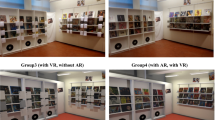Abstract
Human-Computer Interaction (HCI) is a term known since the early 1980s. In HCI, the user plays the central role, much more than the computer hardware or software by itself. It is a multi-disciplinary research field, populated by researchers and practitioners from areas like psychology and cognitive sciences, ergonomics, sociology, computer science, graphic design, business, and more. In order to build really usable interfaces, the knowledge and engagement of every single related field are basic prerequisites. We are taking a look on how selected areas have contributed to HCI in recent years.



Similar content being viewed by others
References
Wikipedia (2012) Human-computer interaction. http://www.wikipedia.org. Last visited January
Hewett T (chairman) (1992) ACM SIGCHI curricula for human-computer interaction. Technical report, ACM. Last updated 2009
International Organization for Standardization (1998) ISO 9241-11 (guidance on usability)
International Organization for Standardization (1998) ISO 13407: human-centered design processes for interactive systems
Stone D, Jarrett C, Woodroffe M, Minocha S (2005) User interface design and evaluation. Morgan Kaufmann/Elsevier, Los Altos
Toffler A (1970) Future shock. Bantam Press
Foraker Labs (2012) Usability first: glossary. http://www.usabilityfirst.com/glossary. Last visited January 2012
Perlin K, Fox D (1993) Pad: an alternative approach to the computer interface. In: Proceedings of the 20th annual ACM conference on computer graphics (SIGGRAPH’93). ACM, New York, pp 57–64
Plaisant C, Carr D, Shneiderman B (1995) Image-browser taxonomy and guidelines for designers. IEEE Softw 12(2):21–32
Kadmon N, Shlomi E (1978) A polyfocal projection for statistical surfaces. Cartograph 15(1):36–40
Furnas GW (1999) The FISHEYE view: a new look at structured files. In: Card S, Mackinlay J, Shneiderman B (eds) Information visualization: using vision to think. Morgan Kaufmann, Los Altos, pp 145–152
Tan DS Exploiting the cognitive and social benefits of physically large displays. PhD dissertation, Carnegie Mellon University, School of Computer Science, 2004
Hawkey K, Kellar M, Reilly D, Whalen T, Inkpen KM (2005) The proximity factor: impact of distance on co-located collaboration. In: Proceedings of the international ACM SIGGROUP conference on supporting group work (GROUP’05). ACM, New York
Swaminathan K, Sato S (1997) Interaction design for large displays. Interactions 4(1):593–613
Shneiderman B (1987) Direct manipulation: a step beyond programming languages. In: Readings in human-computer interaction: a multidisciplinary approach
Sears A, Shneiderman B (1991) High precision touchscreens: design strategies and comparisons with a mouse. Int J Man-Mach Stud 34(4):593–613
Ni T, Schmidt GS, Staadt OG, Livingston MA, Ball R, May R (2006) A survey of large high-resolution display technologies, techniques, and applications. In: Proceedings of the IEEE international virtual reality conference (VR 2006)
Robertson G, Czerwinski M, Baudisch P, Meyers B, Robbins D, Smith G, Tan D (2005) The large-display user experience. IEEE Comput Graph Appl 25(4):44–51
Ware C (2004) Information visualization: perception for design, 2nd edn. Morgan Kaufmann, Los Altos
Baudisch P, Cutrell E, Robbins D, Czerwinski M, Tandler P, Bederson B, Zierlinger A (2003) Drag-and-pop and drag-and-pick: techniques for accessing remote screen content on touch- and pen-operated systems. In: Proceedings of interact 2003, pp 57–64
Ebert A, Thelen S, Olech P-S, Meyer J, Hagen H (2010) Tiled++: an enhanced tiled hi-res display wall. IEEE Trans Vis Comput Graph 16(1):120–132
Byrne MD (2003) Cognitive architecture. In: Jacko AJ, Sears A (eds) The human computer interaction handbook. Erlbaum, Hillsdale, pp 97–117
Tuck M (2010) Gestalt principles applied in design (Aug 17 2010). http://sixrevisions.com/web_design/gestalt-principles-applied-in-design. Retrieved January 16
Changizi MA et al. (2008) Perceiving the present and a systematization of illusions. Cogn Sci 32(3):459–503
Most SB (2010) What’s “inattentional” about inattentional blindness? Conscious Cogn 19:1102–1104
Van der Veer GC, Puerta Melguizo MC (2003) Mental models. In: Jacko AJ, Sears A (eds) The human computer interaction handbook. Erlbaum, Hillsdale, pp 52–80
MacKenzie IS (1992) Fitts’ law as a research and design tool in human-computer interaction. Int J Hum-Comput Interact 7(1):91–139
Jordan B (1996) Ethnographic workplace studies and computer supported cooperative work. In: Shapiro D, Tauber M, Traunmüller R (eds) The design of computer-supported cooperative work and groupware systems. North Holland/Elsevier, Amsterdam, pp 17–42
Van der Veer GC, Kulyk O, Vyas D, Kubbe O, Ebert A (2011) Task modeling for collaborative authoring. In: Dittmar A, Forbrig P (eds), Designing collaborative activities, proceedings of ECCE 2011, ACM Digital Library, pp 171–178
Facebook. http://www.facebook.com
Facebook Group “IsHCI-NameOutdated?” http://www.facebook.com/groups/240802732665063/
Author information
Authors and Affiliations
Corresponding author
Rights and permissions
About this article
Cite this article
Ebert, A., Gershon, N.D. & van der Veer, G.C. Human-Computer Interaction. Künstl Intell 26, 121–126 (2012). https://doi.org/10.1007/s13218-012-0174-7
Received:
Accepted:
Published:
Issue Date:
DOI: https://doi.org/10.1007/s13218-012-0174-7




